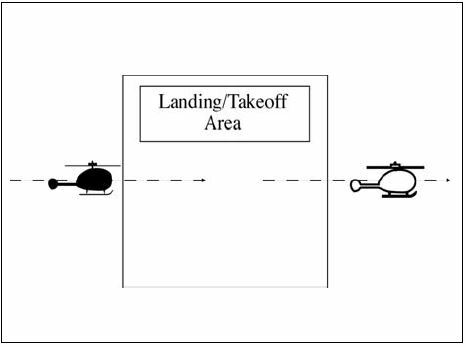Section 11. Helicopter Operations
- When necessary for a wheeled helicopter to taxi on the surface, use the phraseology in paragraph 3-7-2, Taxi and Ground Movement Operations.
NOTE-
Ground taxiing uses less fuel than hover‐taxiing and minimizes air turbulence. However, under certain conditions, such as rough, soft, or uneven terrain, it may become necessary to hover/air‐taxi for safety considerations. Helicopters with articulating rotors (usually designs with three or more main rotor blades) are subject to “ground resonance” and may, on rare occasions, suddenly lift off the ground to avoid severe damage or destruction.
- When requested or necessary for a helicopter/VTOL aircraft to proceed at a slow speed above the surface, normally below 20 knots and in ground effect, use the following phraseology, supplemented as appropriate with the phraseology in paragraph 3-7-2, Taxi and Ground Movement Operations.
PHRASEOLOGY-
HOVER‐TAXI (supplemented, as appropriate, from paragraph 3-7-2, Taxi and Ground Movement Operations.)
CAUTION (dust, blowing snow, loose debris, taxiing light aircraft, personnel, etc.).
NOTE-
Hover‐taxiing consumes fuel at a high burn rate, and helicopter downwash turbulence (produced in ground effect) increases significantly with larger and heavier helicopters.
REFERENCE-
P/CG Term - HOVER TAXI.
AIM, Para 4-3-17, VFR Helicopter Operations at Controlled Airports.
- When requested or necessary for a helicopter to proceed expeditiously from one point to another, normally below 100 feet AGL and at airspeeds above 20 knots, use the following phraseology, supplemented as appropriate with the phraseology in paragraph 3-7-2, Taxi and Ground Movement Operations.
PHRASEOLOGY-
AIR‐TAXI:
VIA (direct, as requested, or specified route)
TO (location, heliport, helipad, operating/movement area, active/inactive runway).
AVOID (aircraft/vehicles/personnel).
If required,
REMAIN AT OR BELOW (altitude).
CAUTION (wake turbulence or other reasons above).
LAND AND CONTACT TOWER,
or
HOLD FOR (reason- takeoff clearance, release, landing/taxiing aircraft, etc.).
NOTE-
Air‐taxi is the preferred method for helicopter movements on airports provided ground operations/conditions permit. Air‐taxi authorizes the pilot to proceed above the surface either via hover‐taxi or flight at speeds more than 20 knots. Unless otherwise requested or instructed, the pilot is expected to remain below 100 feet AGL. The pilot is solely responsible for selecting a safe airspeed for the altitude/operation being conducted.
REFERENCE-
P/CG Term - AIR TAXI.
AIM, Para 4-3-17, VFR Helicopter Operations at Controlled Airports.
|
WAKE TURBULENCE APPLICATION |
|---|
- Avoid clearances which require small aircraft or helicopters to taxi in close proximity to taxiing or hover‐taxi helicopters.
REFERENCE-
AC 90-23, Aircraft Wake Turbulence, Para 10 and Para 11.
- Issue takeoff clearances from movement areas other than active runways or in diverse directions from active runways, with additional instructions as necessary. Whenever possible, issue takeoff clearance in lieu of extended hover-taxi or air-taxi operations.
PHRASEOLOGY-
(Present position, taxiway, helipad, numbers) MAKE RIGHT/LEFT TURN FOR (direction, points of compass, heading, NAVAID radial) DEPARTURE/DEPARTURE ROUTE (number, name, or code), AVOID (aircraft/vehicles/personnel),
or
REMAIN (direction) OF (active runways, parking areas, passenger terminals, etc.).
CAUTION (power lines, unlighted obstructions, trees, wake turbulence, etc.).
CLEARED FOR TAKEOFF.
- If takeoff is requested from non-movement areas, an area not authorized for helicopter use, or an area off the airport, and, in your judgment, the operation appears to be reasonable, use the following phraseology instead of the takeoff clearance in subparagraph a.
PHRASEOLOGY-
DEPARTURE FROM (requested location) WILL BE AT YOUR OWN RISK (additional instructions, as necessary). USE CAUTION (if applicable).
- Unless agreed to by the pilot, do not issue downwind takeoffs if the tailwind exceeds 5 knots.
NOTE-
A pilot request to takeoff from a given point in a given direction constitutes agreement.
Separate a departing helicopter from other helicopters by ensuring that it does not takeoff until one of the following conditions exists:
NOTE-
Helicopters performing air‐taxiing operations within the boundary of the airport are considered to be taxiing aircraft.
- A preceding, departing helicopter has left the takeoff area. (See FIG 3-11-1.)

- A preceding, arriving helicopter has taxied off the landing area. (See FIG 3-11-2.)

Separate an arriving helicopter from other helicopters by ensuring that it does not land until one of the following conditions exists:
-
A preceding, arriving helicopter has come to a stop or taxied off the landing area.
(See FIG 3-11-3 and FIG 3-11-4.)


- A preceding, departing helicopter has left the landing area. (See FIG 3-11-5.)

Authorize helicopters to conduct simultaneous landings or takeoffs if the distance between the landing or takeoff points is at least 200 feet and the courses to be flown do not conflict. Refer to surface markings to determine the 200 foot minimum, or instruct a helicopter to remain at least 200 feet from another helicopter. (See FIG 3-11-6.)

- Issue landing clearances to helicopters going to movement areas other than active runways or from diverse directions to points on active runways, with additional instructions as necessary. Whenever possible, issue a landing clearance in lieu of extended hover-taxi or air-taxi operations.
PHRASEOLOGY-
MAKE APPROACH STRAIGHT-IN/CIRCLING LEFT/RIGHT TURN TO (location, runway, taxiway, helipad, Maltese cross) ARRIVAL/ARRIVAL ROUTE (number, name, or code).
HOLD SHORT OF (active runway, extended runway centerline, other).
REMAIN (direction/distance; e.g., 700 feet, 1 1/2 miles) OF/FROM (runway, runway centerline, other helicopter/aircraft).
CAUTION (power lines, unlighted obstructions, wake turbulence, etc.).
CLEARED TO LAND.
- If landing is requested to non-movement areas, an area not authorized for helicopter use, or an area off the airport, and, in your judgment, the operation appears to be reasonable, use the following phraseology instead of the landing clearance in subparagraph a.
PHRASEOLOGY-
LANDING AT (requested location) WILL BE AT YOUR OWN RISK (additional instructions, as necessary). USE CAUTION (if applicable).
- Unless agreed to by the pilot, do not issue downwind landings if the tailwind exceeds 5 knots.
NOTE-
A pilot request to land at a given point from a given direction constitutes agreement.